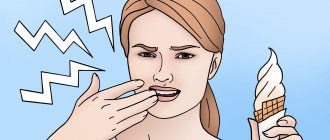Symptoms of periodontitis
Let's start with the fact that in the initial stages the disease occurs without symptoms, and it can only be detected at a dentist's appointment; this will require an x-ray. Symptoms appear in the stage of acute periodontitis or as a result of exacerbation of the chronic form. Among the signs of the disease:
- sharp or aching pain;
- swelling of the gums in the affected area;
- feeling as if the tooth has become taller;
- temperature increase;
- sleep disturbance;
- tooth mobility;
- tissue redness;
- pain when touching a tooth or chewing food.
If at least two symptoms occur, contact your dentist.
Causal relationship
Treatment of caries and pulp removal are two different procedures, and therefore they should be considered separately. In the first case, pain when pressing on the filling may occur due to the irregular shape or size of the surface in contact with other teeth. In other words, an increased load will be placed on the protruding part, which will not cause the most pleasant sensations. Among the most common causes, it is also worth highlighting poor-quality removal of the affected tissue, incorrect diagnosis, overheating of the pulp, which resulted in burns and other injuries. It is worth noting that all of the above factors fall into the category of medical failures.
Pain after depulpation has a different nature, with the exception of the possibility of poor-quality removal of the affected area, in this case the pulp. Rehabilitation time can reach 2 weeks. If at the end of this period the pain has not subsided, most likely the procedure was not carried out entirely correctly. The irritant can be a hole in the tooth root (perforation), a fragment of a dental instrument, the presence of areas of the canal that are not filled with photographic material, and some others. Pain caused by strong pressure on a tooth after root canal filling should be a signal to return to the clinic. Any of the above reasons requires immediate correction.
Stages and forms of the disease
Periodontitis is divided according to the general principle into chronic and acute. Chronic cannot be completely cured. It is only possible to eliminate local inflammation and stop further exacerbation of the disease. Chronic periodontitis is asymptomatic and does not bother the carrier, but in case of exacerbation of the disease, symptoms begin to appear. In a calm state, a small fistula may appear on the gum from time to time, and slight discomfort may occur when chewing food or mechanical impact on the area of inflammation. If left untreated for a long time, the risk of tooth loss is high.
Treatment of acute periodontitis has an end result. But even after complete recovery, control over the oral cavity is necessary to avoid re-inflammation. In acute periodontitis, all of the listed symptoms are characteristic, only 2-3 of them may appear, and this is already a signal to visit the dentist. Purulent periodontitis is especially pronounced. In this case, the pain is acute, body temperature rises, and gumboil formation is possible.
Forms of periodontitis:
- Fibrous. In this case, periodontal tissue is replaced by fibrous tissue. It is often asymptomatic and can be detected by external signs: changes in enamel color, bad breath, pulp death.
- Granulating. It leaks quickly and destroys bone tissue. It is characterized by painful sensations when pressing on the gums or chewing food. A pulling or bursting pain may be observed without mechanical impact on the tooth.
- Granulomatous. This is a dangerous type of disease because it is asymptomatic, while destructive processes take place inside the periodontium, which are accompanied by the appearance of cysts and granulomas. If left untreated, the tooth may simply fall out. An infection locked in a granuloma or cyst can “explode” under the influence of the slightest irritant: provoke inflammation (for example, sepsis).
- Apical. The simplest form, easy to treat. It occurs as a result of untreated pulpitis and is localized in one place near the root.
What do toothache and stomach pain have in common?
Of course, both toothache and peptic ulcer bring a lot of inconvenience and knock a person out of his normal rhythm of life. However, unlike toothache, an exacerbation of an “ulcer” can be fatal (and even lethal!) for life.
At a time when week after week passes in constant tension and stress, quick satiation foods come to our aid. As a rule, even in a skinny pocket there is a “ruble” for a soda or a chocolate bar. But at the same time, there is not always time to pay attention to your teeth and take care of the cleanliness of your mouth. It is unlikely that anyone on the street will take out a toothbrush after eating a candy bar or start loudly rinsing their mouth on the bus.
Day after day, this lifestyle leads to the fact that tooth enamel becomes more and more susceptible to destruction, and gums - to inflammation. Ultimately, untreated caries is complicated by pulpitis, and children's fear of dentists and terrible drills overcomes common sense. Experiencing severe pain, a person runs or sends loved ones to the nearest pharmacy for a miracle pill.
At the pharmacy, the choice of analgesics and non-steroidal anti-inflammatory drugs is extremely large. The most commonly purchased drugs for toothache include the following: Diclofenac (= Ortofen), Ketorolac (= Ketanov), Nimesulide (= Nise), Ketoprofen, Ibuprofen, Analgin and Paracetamol.
Based on my experience working in a pharmacy, eight out of ten customers with acute toothache will ask for Ketanov (= Ketorol). And almost none of them are aware of how to take this drug correctly, what side effects it has.
One way or another, any NSAID (non-steroidal anti-inflammatory drug) has an ulcerogenic effect of varying severity (the ability to influence the formation of erosive and ulcerative defects in the gastrointestinal mucosa). Which also depends on the dose, frequency and duration of use.
In the course of numerous studies, it has long been known that Ketorolac has a powerful ulcer-forming effect, and is the world leader in mortality from hemorrhagic complications during its uncontrolled use.
To confirm this, I will tell you an incident from a pharmacy. One day, early in the morning, a young man came in and asked Ketanov for a toothache. I asked for a prescription for this drug, to which the guy sadly replied that he did not have a prescription, but he had been drinking Ketanov for the last month. Of course, as it turned out, he didn’t know about the side effects.
Of course, it is necessary to contact your dentist in a timely manner. It is better before pain appears. And if it does arise, there’s no point in delaying it, not at all. If it so happens that you have to take aggressive NSAIDs, then do not forget about protecting the stomach: there is a large selection of antacids and proton pump inhibitors (drugs used in the treatment of erosive gastritis and peptic ulcers).
Monitor your well-being. Do not take lightly the first heaviness and pain in the abdomen after eating or, conversely, on an empty stomach.
Don't be afraid of doctors. Periodically visit a gastroenterologist, perhaps he will advise you to conduct a study such as fibrogastroduodenoscopy, the result of which will be 100% clear in what state your stomach is, so often beaten by buns, chocolates and packs of pills.
Possible consequences of an over-inflated filling:
- When the filling is too high, an increased load falls on the tooth; when the mouth is closed, the teeth of the opposite jaw put pressure on the filling. Thus, chronic tooth injury occurs. Constant pressure on the tooth can lead to traumatic pulpitis and periodontitis. As a result, the tooth will need to be depulped.
- With constant increased load on the filling, there is a risk of its chipping, as well as the chipping of the tooth wall.
- If, when closing the mouth, the teeth close together on one side (on an over-inflated filling), but the teeth on the other side do not close, then a kind of “distortion” occurs; the lower jaw may move to the side when closing the mouth. If you tolerate such an inconvenience, your body will eventually get used to it and stop noticing it. However, the problem will remain. The unusual position of the lower jaw when closing the teeth and blocking its lateral displacements can lead to diseases of the temporomandibular joints. Pain, crunching, clicking in the joints of the lower jaw - all this can be a symptom of a disease, which can be caused by over-inflated fillings.
What is the temporomandibular joint - TMJ
We use this joint while talking, chewing, yawning, laughing - very often. Around it are muscles and tendons that allow the jaw to move in different directions for different purposes.
TMJ problems occur for many reasons:
- violation of the dental system, for example, congenital anomalies of teeth, gums or bone tissue, malocclusions, injuries, poor-quality prosthetics;
- congenital anatomical abnormalities of this joint;
- increased or decreased tone of muscle fibers around the TMJ;
- active conversational load, for example, among actors, singers, speakers;
- central nervous system problems;
- disruptions in the functioning of the endocrine system;
- excessive tension of the jaw muscles, for example, due to the bad habit of biting nails.
What is the temporomandibular joint and why do problems arise with it? Detailed and clear - in the video:
Actors and singers with active oratorical articulation are at risk for TMJ arthrosis
Tooth mobility
Physiological mobility of teeth is normally practically unnoticeable and ranges from 0.06 to 0.15 mm. It occurs as a result of stretching of the fibers of the periodontal ligament (connects the tooth to the alveolar bone) and elastic deformation of the alveolar process. However, in some cases, pathological tooth mobility may occur, which disrupts the periodontal junction and increases the risk of tooth loss.
Causes
The causes of pathological tooth mobility are usually:
- pathological process in periodontal tissues (periodontitis, periodontal disease);
- occlusal injury.
In turn, traumatic occlusion can be:
- primary
- occurs as a result of strong and prolonged load on the periodontium, pathological changes in which occur locally and affect a limited number of teeth:- overbite after placement of fillings, inlays, crowns and dentures;
- irrational orthodontic treatment;
- dental deformations (crowding of teeth, deep bite);
- parafunctions (bruxism);
- secondary
- develops as a consequence of inflammation and destructive changes in the periodontium; - combined
- when the periodontium, weakened during the pathological process, is subjected to a high occlusal load.
In some systemic diseases, for example, metabolic disorders and other pathologies of the endocrine system (in particular, dysfunction of the parathyroid gland), mobility can be temporary or progressive, for example, in diabetes mellitus.
There are several degrees:
- the tooth moves in one, for example, vestibular, distal or other direction;
- mobility is already observed in two directions;
- the tooth is loose in both the vestibular-oral and media-distal directions;
- the tooth moves vertically, there is a high risk of falling out.
The degree of mobility is closely related to the severity of destruction of the ligamentous apparatus and in many cases is determined by the nature of the pathological process in periodontal tissues. It is strongest when detecting alveolar bone resorption.
Clinical picture
If tooth mobility occurs against the background of traumatic occlusion, additional clinical symptoms may include pathological abrasion, muscle hypertonicity, root resorption, etc. Pain occurs during percussion and eating.
Diagnosis and treatment
To determine tooth mobility, the doctor usually uses tweezers or a probe. Using a dental instrument, slight pressure is applied to the tooth (rocking) in all directions. The obtained data are entered into an odonto-periodontogram and allow one to assess the degree of functional periodontal insufficiency.
The scope of medical manipulations and therapeutic tactics are selected based on the general somatic status of the patient. The first priority is always the elimination of acute inflammation. Professional oral hygiene and antimicrobial therapy are mandatory.
Treatment of tooth mobility may include grinding teeth, normalizing occlusal relationships, splinting and prosthetics. As part of orthodontic treatment, including through bite correction, the load on the periodontium can be normalized and stabilized, after which the pathological process in it stops, the teeth occupy a stable position.
Read more:
- What does a periodontist do?










